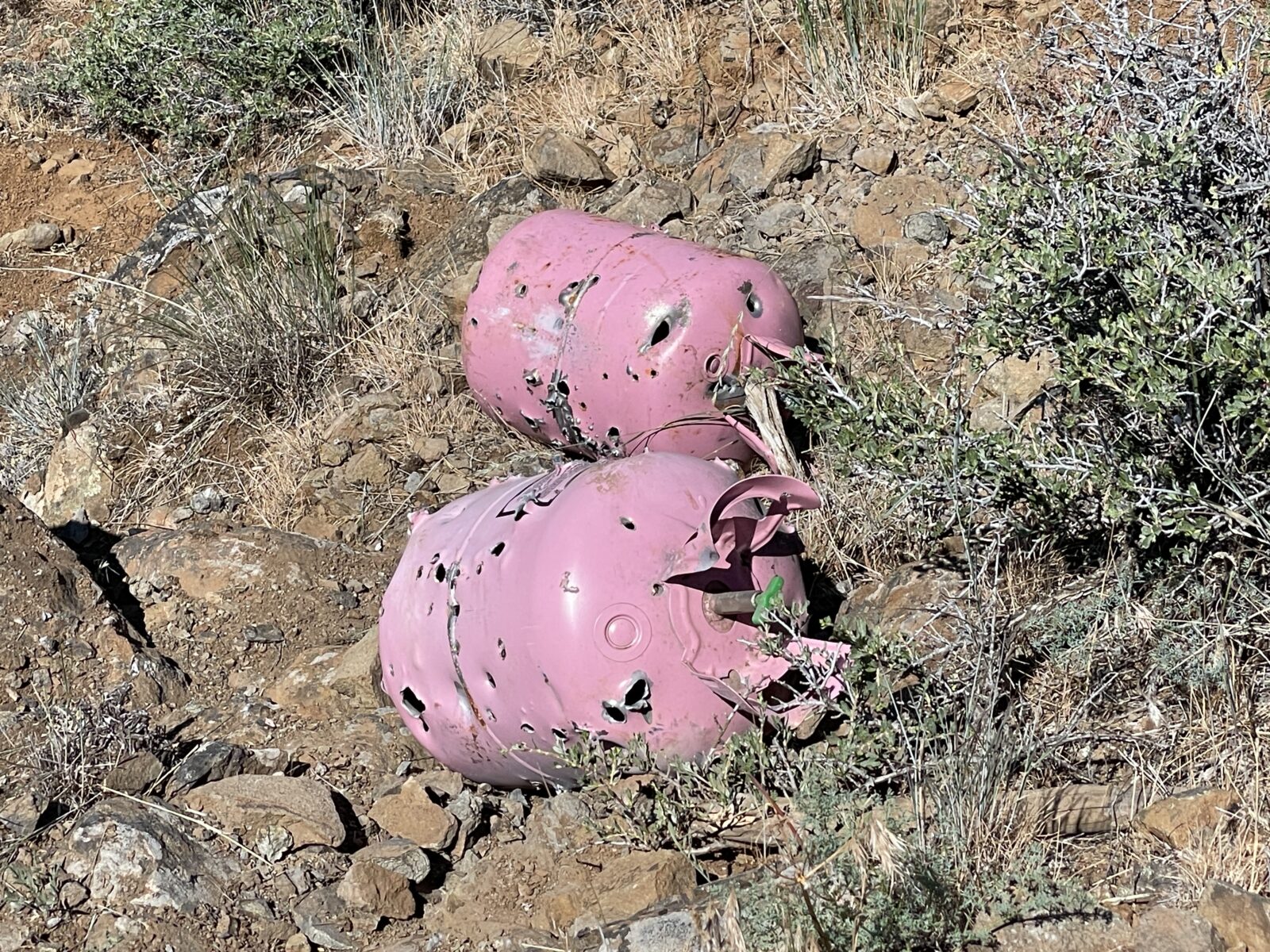I wrapped up another field day with my friend Paul (W7PEZ) in Eastern Washington. For the two days, I had 204 contacts, broken out roughly as:

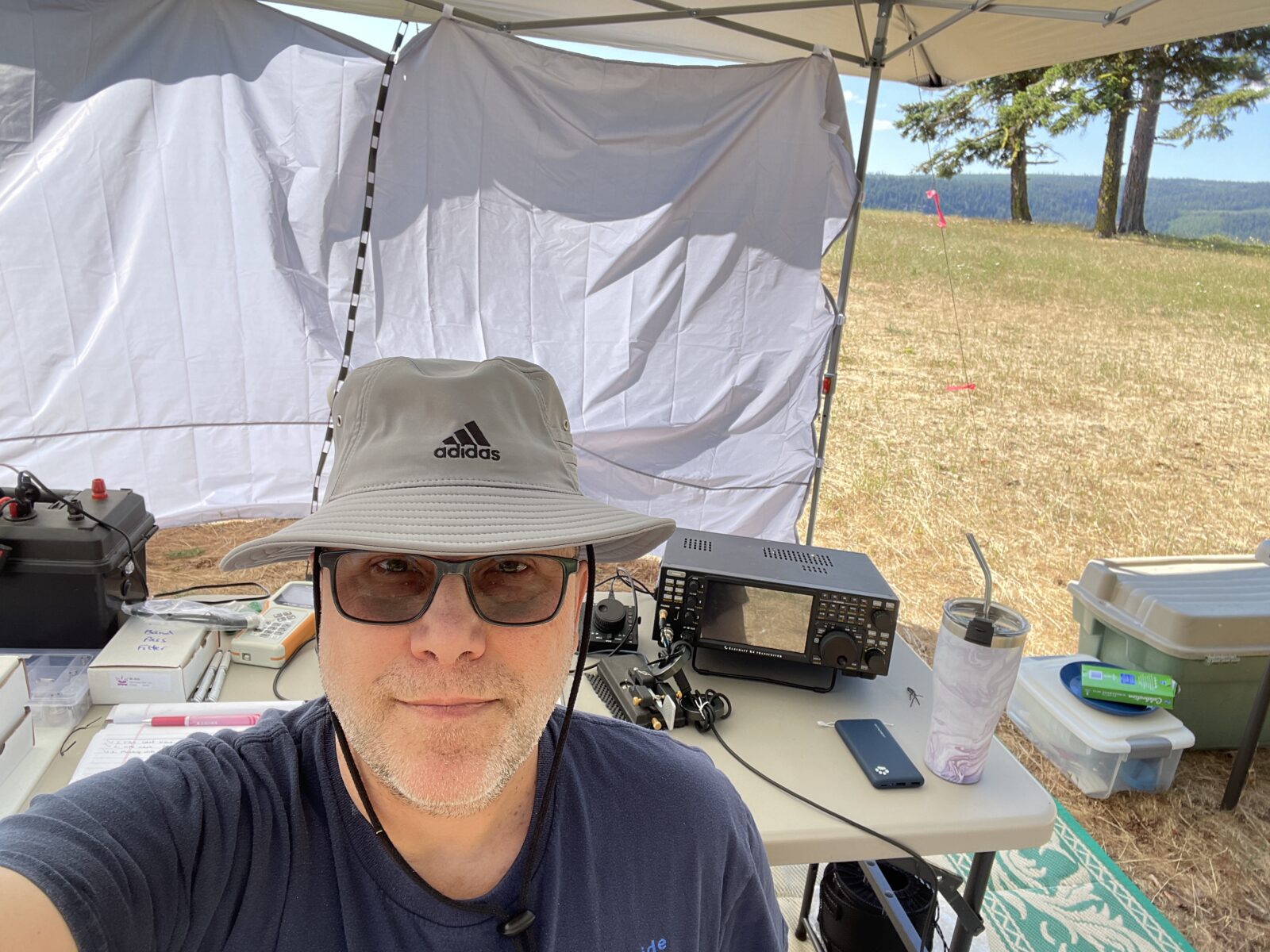
Paul worked 200 contacts, nearly all CW. Both are personal records. Neither of us were “running,” which would certainly have bumped up the totals, nor did we operate all the time, because most of the fun of Field Day is Everything Else.
Although our site is at the end of a long, windy, sometimes awful forest road (which I realize is redundant) that few people venture, Paul got there late morning to claim the spot. On the drive out, we out, we scouted alternate locations should this space be unavailable next year.
I had some work to do in the morning, but left home mid-afternoon, picking up ice, a steak, and sundry items that were omitted (knife, cutting board, saute pan, dish soap, paper plates). On my way there, the first of a series of thunderstorms were rolling through — not much rain, but gusty. We waited until it looked done before anchoring down everything very well. `
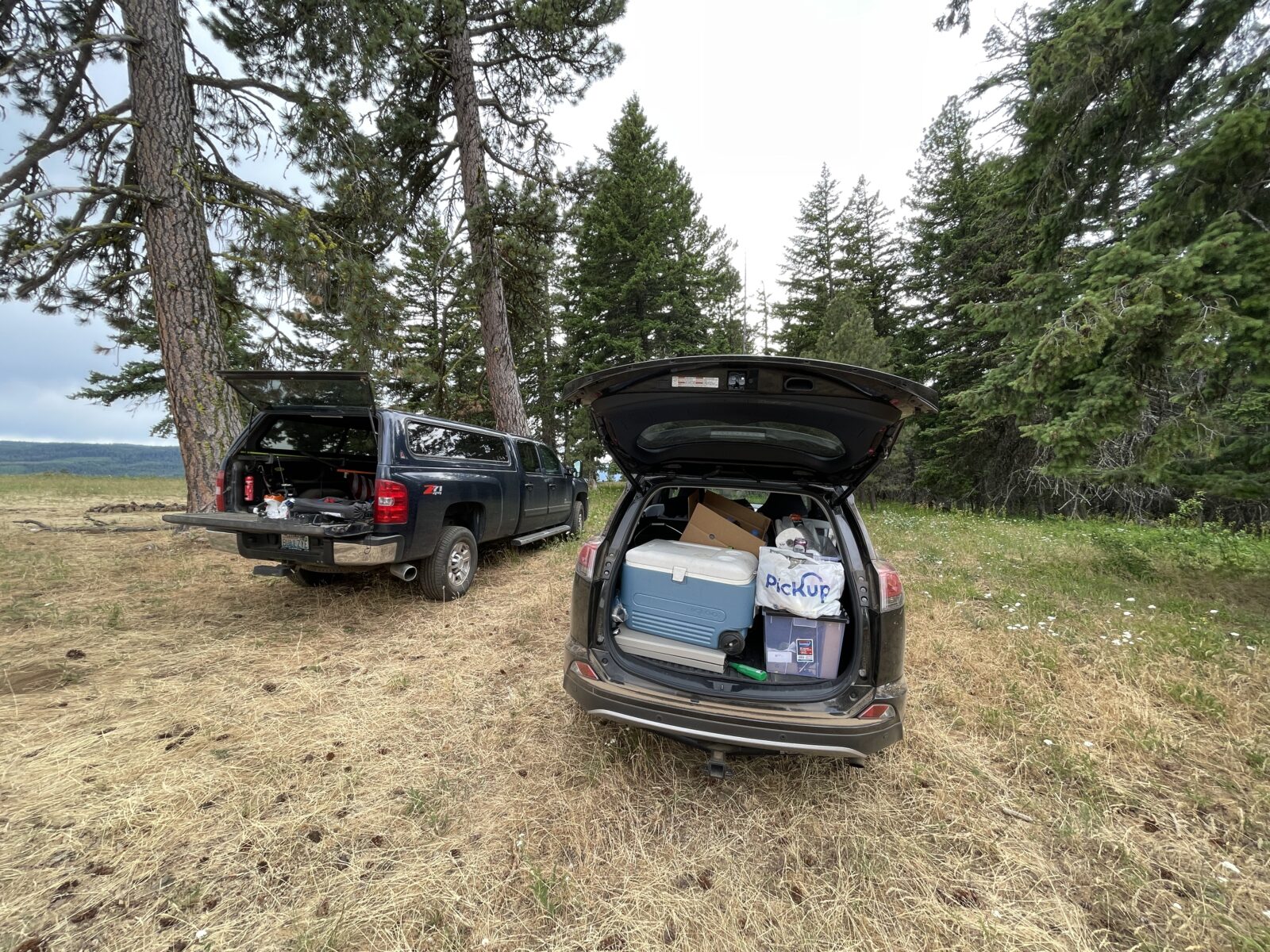
Now that my K4D officially is beyond its factory warranty, I had little hesitation at bringing it this year. The Elecraft Pizza Box worked well for transport, I just wish it had more cutouts or bigger pockets for essential cables to keep everything in one spot.
The K4 was a niiiiiiice improvement over the KX3 for a variety of reasons:
- I could run at up to 100W (versus a max of 10 with the KX3). In practice, I stuck around 50 unless I was trying for an east coast station on SSB.
- Pan adapter was useful in quickly checking if there was any activity on a band (e.g., 10m: no, 15m and 40m: yes)
- Recent familiarity. Last year, after not using the KX3 for four months, I had a senior moment when I had to remember the controls. After fifteen minutes, muscle memory was back.
- Better filtering. Although this is a low-noise environment, Field Day is band mayhem as people practice poor radio operator-ship, working on top of each other and calling without listening. Being able to filter adjacent noise was helpful to productivity.
Things that worked well:
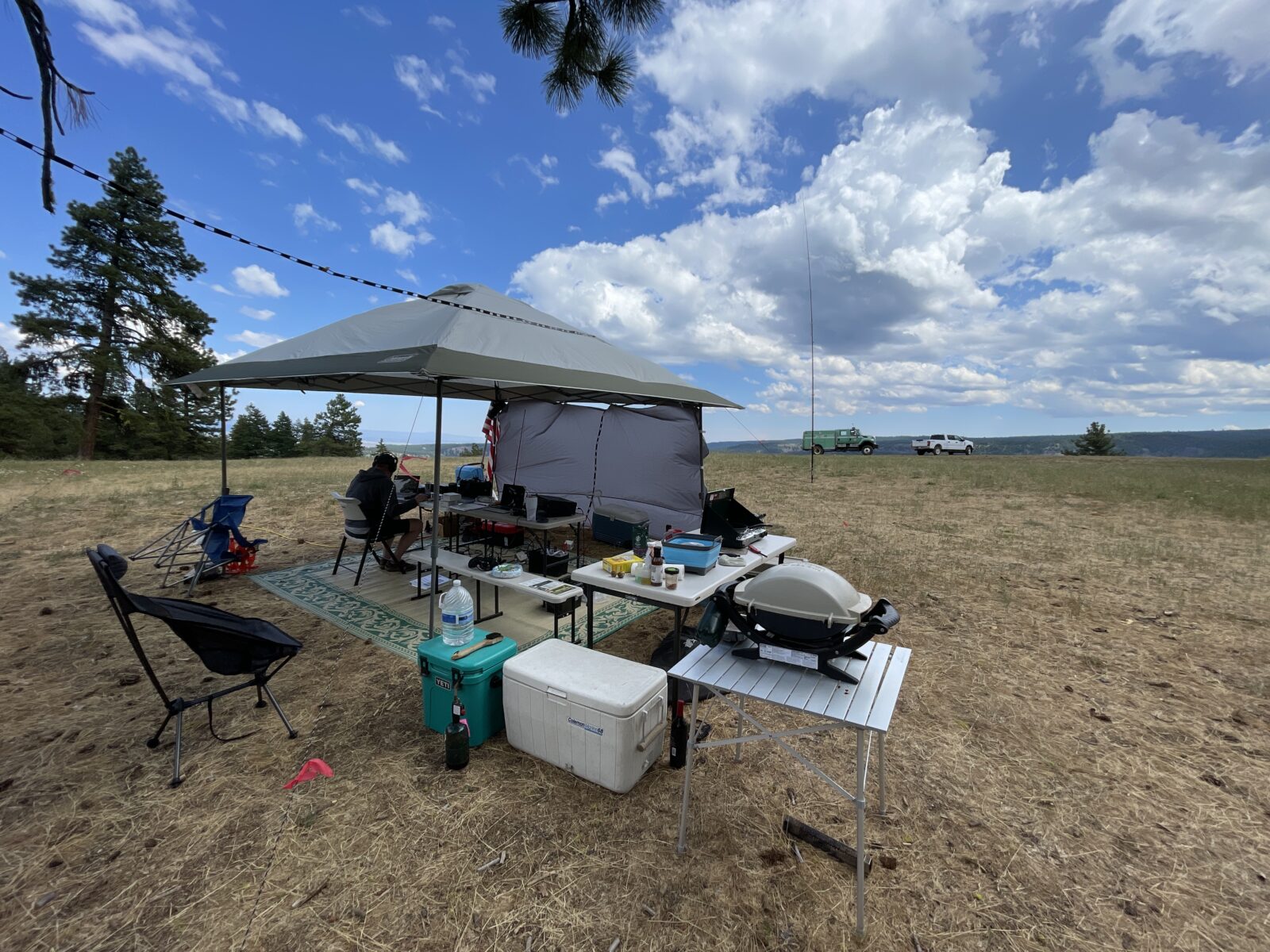
- Both of us facing the same direction. Last year, we sat opposite, which was great for being able to talk across the table or me watching cat videos while pretending to operate (just kidding). Having both of us on one side avoided sun on the monitor, and left a lot of room to get behind them and play with wiring. This was especially important when we were swapping …
- Band-pass filters. Last year there was interference between radios, primarily the 7300 (at 100w) to the KX3 (at 10w) when PEZ was operating on 20m and I was trying 40 or 15. This year, we each bought band-pass filters (these allows only a range of frequencies in or out) for the bands we planned to use (e.g., 10, 15, 20 and 40m) and swapped those to reduce interference on the other.
- Battery + generator. tl;dr: This was a great backup, letting us run two stations, two laptops, and charge devices as necessary. I’d acquired a 100Ah lithium-ion battery to use as the primary power for my K4 while Paul had a 20Ah (as his Miady 35Ah had died a few days earlier). In receive, my radio drew about 2A. During transmit time at maximum (100W) power, it’d draw about 20A, though I tended to keep around half power (12A). Paul brought his generator, which we ran periodically to top off the batteries and laptops.
- Separate good antenna systems. Last year we had the 80m horizontal loop and an end-fed. When I was running low power, the loop was great, and the end-fed was acceptable on Paul’s 100w. This year we had … a lot of options (see below), but used primarily the 80m loop and a vertical DX Commander spaced apart. The loop was still superior, but the vertical was comparable.
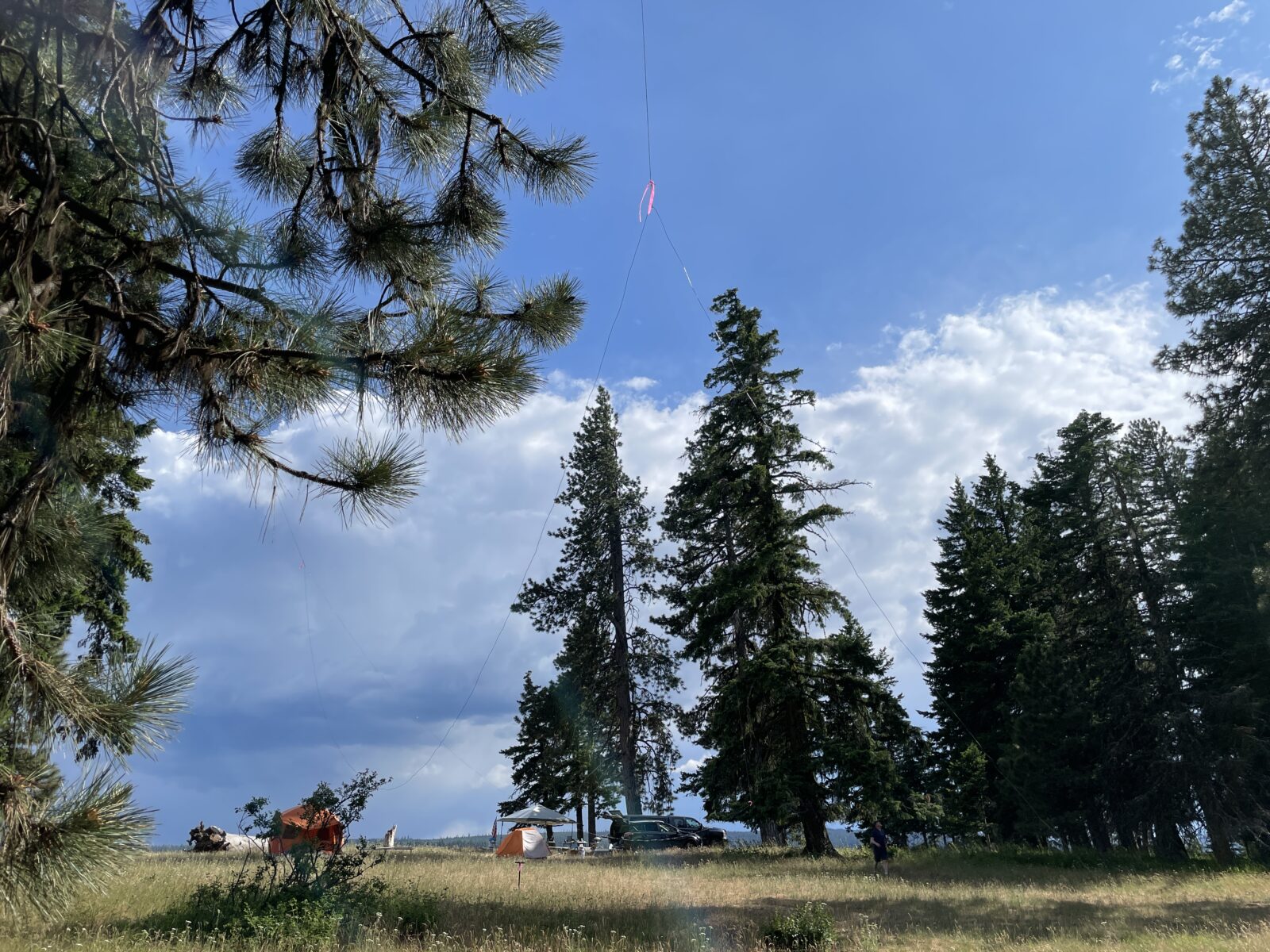
- Antenna launching setup and Flagging tape – we had a pneumatic (pressured with a bike pump) tool to shoot a projectile and fishing line over trees. When this was done, another (old) fishing rod & fluorescent line, thicker rope would be pulled back. Then, finally, Dacron line attached to it as the neon line rolled back. The fishing reels prevent the line from being twisted, which affects how well it unspools during launch. Once the four Dacron lines were run, we added a piece of flagging tape for visibility as it let us see where the corners were. Flagging tape is also useful on shelter tie-downs to reduce the likelihood of running into them in low light.
- Having a clean shirt/underwear/socks for each day, separate sleeping clothes. Being able to swap out clothes close to skin helped deal with the lack of showering. It was also helpful to go for the soft layers at night. When I got home, I noticed everything had a campfire smoky smell to it.
- Having two sun/wind screens to attach to the shelter. Our site had a predominantly southern view. Mounting the sun/wind screens on two sides kept us from direct exposure most of the day because we could leapfrog the screens as the day went on. By the evening, it was below the treeline.
- Luggable Loo. Shit’s eventually going to happen. Last year, I did the dig-a-hole-and-squat before burying everything. At my age, it was a bit awkward. I think that’s when I picked up a tick. This year, I could sit on a 5-gallon bucket with a toilet seat, poop into a plastic pouch with bio-gel, and neatly pack it away in garbage. It was a relative luxury.
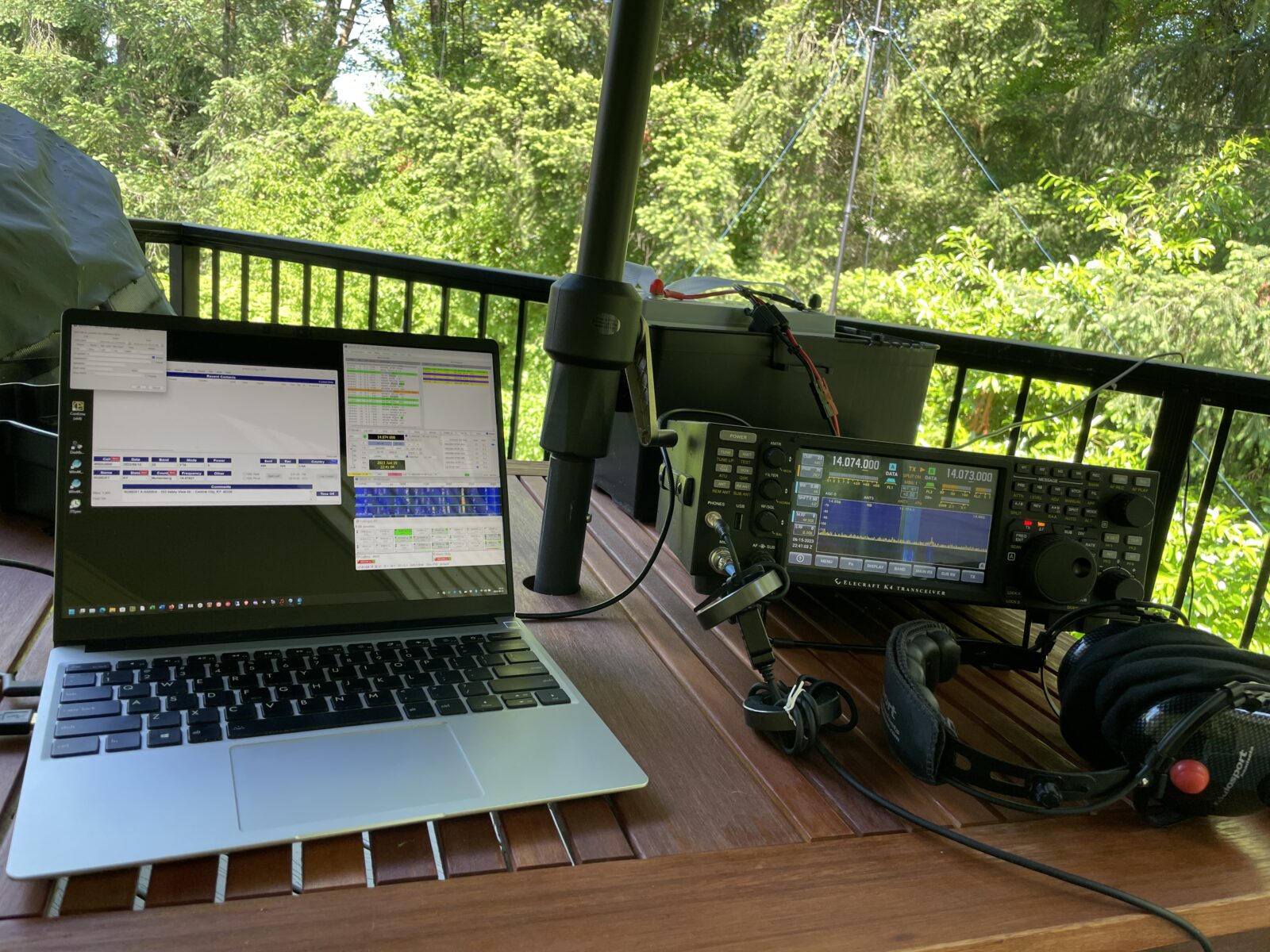
- Practice setting up the K4D on the patio. This was a lot how I first operated in 2017. The main benefit is to ensure I have all the necessary components, connectors, software, and batteries needed for the real thing.
- Paper plates – These can later feed a fire, saving the need for more water, heating it, then dumping it elsewhere. By the end of the day I really didn’t want to do dishes.
- Pre-tuning the DX Commander. The antenna is something I purchased last year (after Field Day 2022), but had recently started assembling. I had a few iterations of setup-adjust-repeat (and later, “give up on the stock wiring, make everything color-coded”) that got it close enough. It was ready to go on 10/15/20/40m for Field Day. There are still opportunities to adjust the connectors to make it quicker to set up. (Also the insulation on the color-coded wire is not that great and wears off easily.)
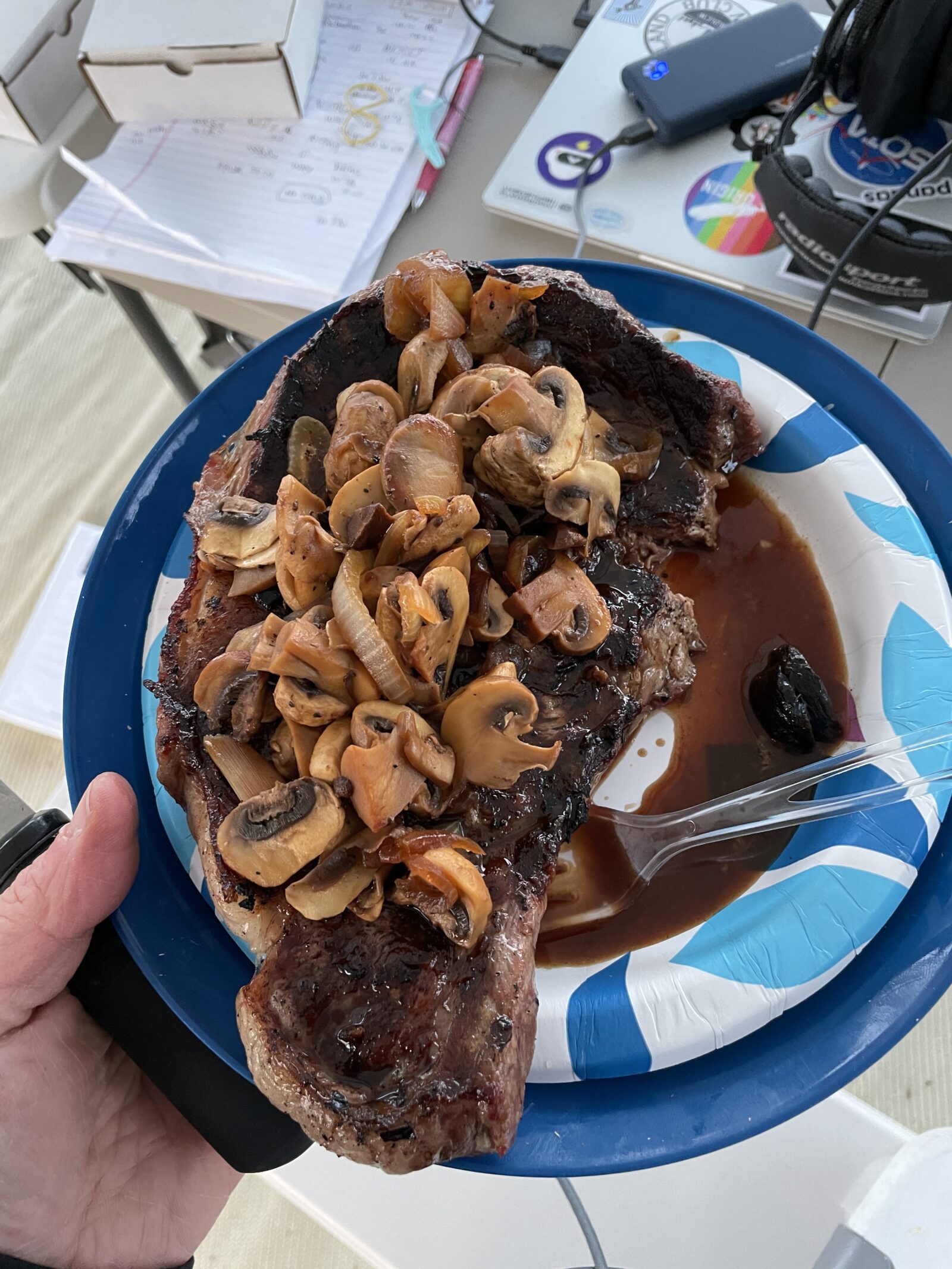
Improvements for next time:
- Don’t Bring So Much Stuff. I had succumbed to might-need-it-itis pretty severely to the point I needed to Tetris things into my car (a minor superpower honed from moving my kids into and out of college dorms). A few things I could have done without: second shelter (we never unpacked it, just like last year), extra antennas like the ZSBKW (an optimized G5RV), off-center fed (aka Widom).
- Larger tent/smaller cot. I didn’t bring my older LuxuryLite cot (from my first Cycle Oregon in 2008) because it saw at saw a lot of wear and tear during its 4-month use as my daughter’s primary apartment bed. I had picked up (impulse buy) at Costco an USFS Cot that looked great in theory, but was too large for my REI Half-Dome tent. Fortunately, Paul’s tent was cavernous and he let me use half. I wouldn’t mind bringing a larger tent next year because I sleep longer & get up to pee at night more often than most.
- Pre-make certain food items. My attempt at Caesar Salad dressing from scratch in the field was awkward, and I’d forgotten the lemon. Doing it in advance would have less stress and mess.
- Better chair. Again, impulse buy at Costco, found a lightweight lounge chair that was great to sit in. But because it was so lightweight, it was prone to being blown into the fire. Another impulse buy was a small, foldable bench to use for better sitting position when operating. While it did the trick, a cushion would have been nice.
- Bring more water. It wasn’t a problem this time because the weather was perfect, but when Paul went to the site the next week with his wife and dogs, he’d consumed a lot more water than planned. I have some 2.5g water cubes that I could use next time. I just need to remember to fill them…
- Bring more garbage bags and a littler grabber tool. The camping area had a lot of garbage dumped in it by previous tenants. The worst was their unsuccessful attempt to burn cans, glass, and (FFS) their lounge chairs. I hauled two shopping bags out but could have done more.
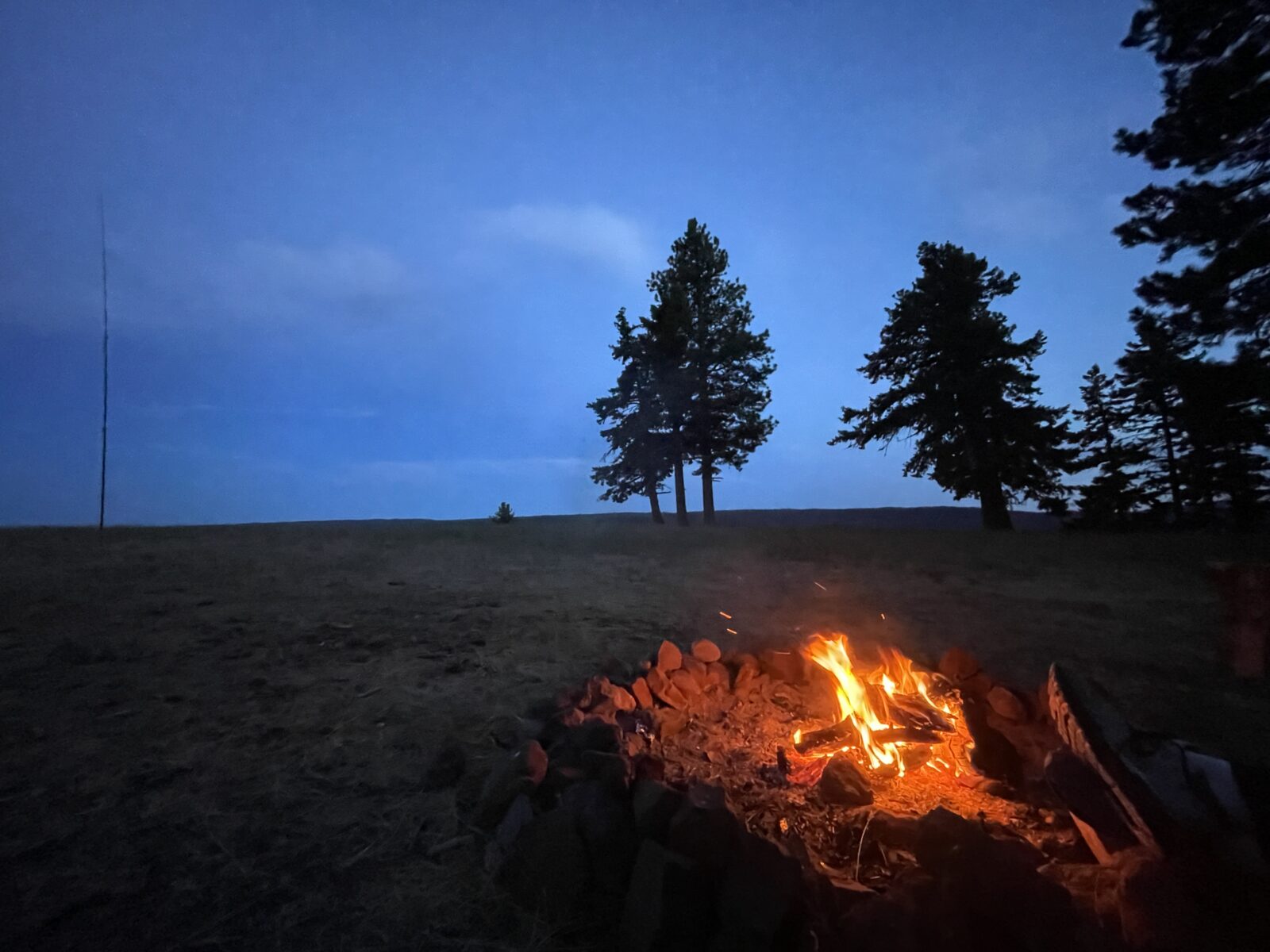
General operating comments:
SSB is always the toughest mode for me. While easiest for anyone to jump on, on Field Day, it seems to attract a lot of bad/lazy behavior like talking without listening first, usually evidenced by someone jumping over everyone (high power), then wasting airtime asking the runner what their call sign is. Had they listened first, it would have been self-evident.
And let’s talk standards. Having earned my pilot’s license decades ago, I was taught the NATO phonetics. That’s also the ICAO official standard in Ham Radio. Except that falls apart on SSB (voice) events where some operators seem to make up their own. Examples I heard:
| A | America | J | Japan | S | Sugar, Sweden |
| B | Boston | K | King, Kilowatt | T | Tokyo, Texas |
| C | Canada | L | London, Lincoln | U | United |
| D | Denmark | M | Mexico | V | Victoria, Venezuela |
| E | England, Eiffel* | N | Norway | W | Washington, William |
| F | France, Florida | O | Ocean, Ontario | X | Xena the Warrior Princess* |
| G | Germany, George | P | Pacific, Peter | Y | Yokohama |
| H | Henry | Q | Queen | Z | Zanzibar, Zed |
| I | Italy | R | Radio |
For some reason, people occasionally copy me as Whisky Echo 8 Papa. If, after trying twice, they’re still getting it wrong, I will reluctantly try “Tokyo” so they hear the T. Each time I do, I feel sad, as if I’ve bounced a landing so hard, I need to go around, while the controller shakes her head, disapprovingly.
CW: This remains my mode of choice, despite there being the gamut of skills and styles. For the life of me, I struggle to understand CW sent by bugs. I found there were several folks who were sending without listening first, and it was worst with someone with a long call sign, sending slowly, multiple times, at ultra-high power. It was best to either move on and come back until they’d gone elsewhere. Conversely, it was pleasant working an experienced op who could be very business-like and efficiently complete a QSO, even in a pileup.
Digital (FT8/FT4): This was not too bad because WSJTX will handle tracking the exchanges, something that wasn’t available in 2018 when I tried it on Field Day last. I used it primarily to work some calls when I needed a mental break because, let’s face it, it’s a lot of clicking on things.
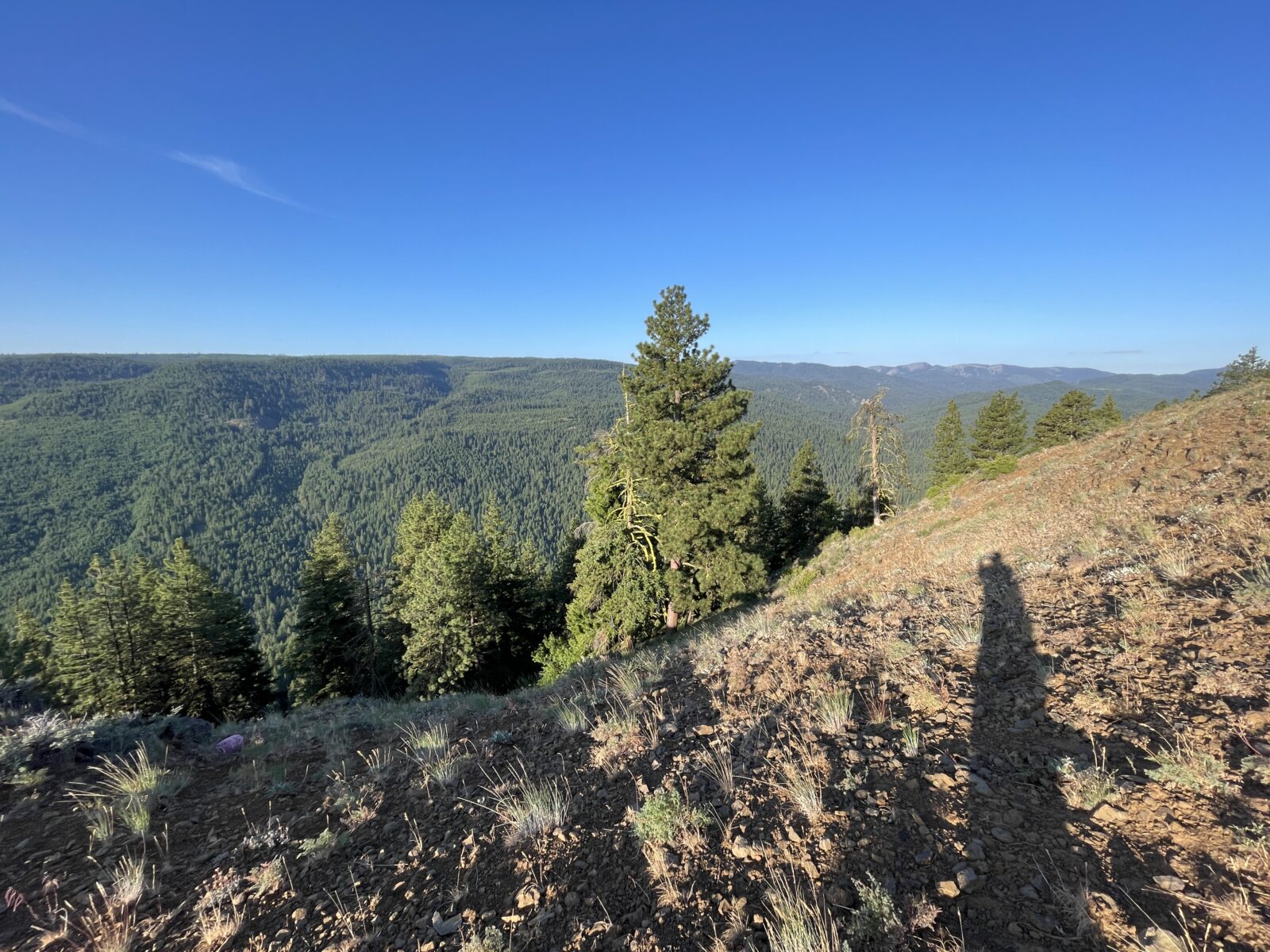
So overall, a great time and one I’ll look forward to next year.
